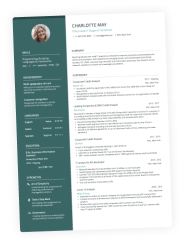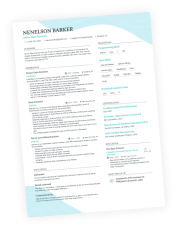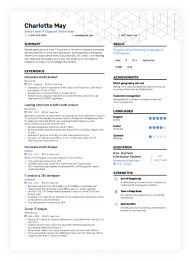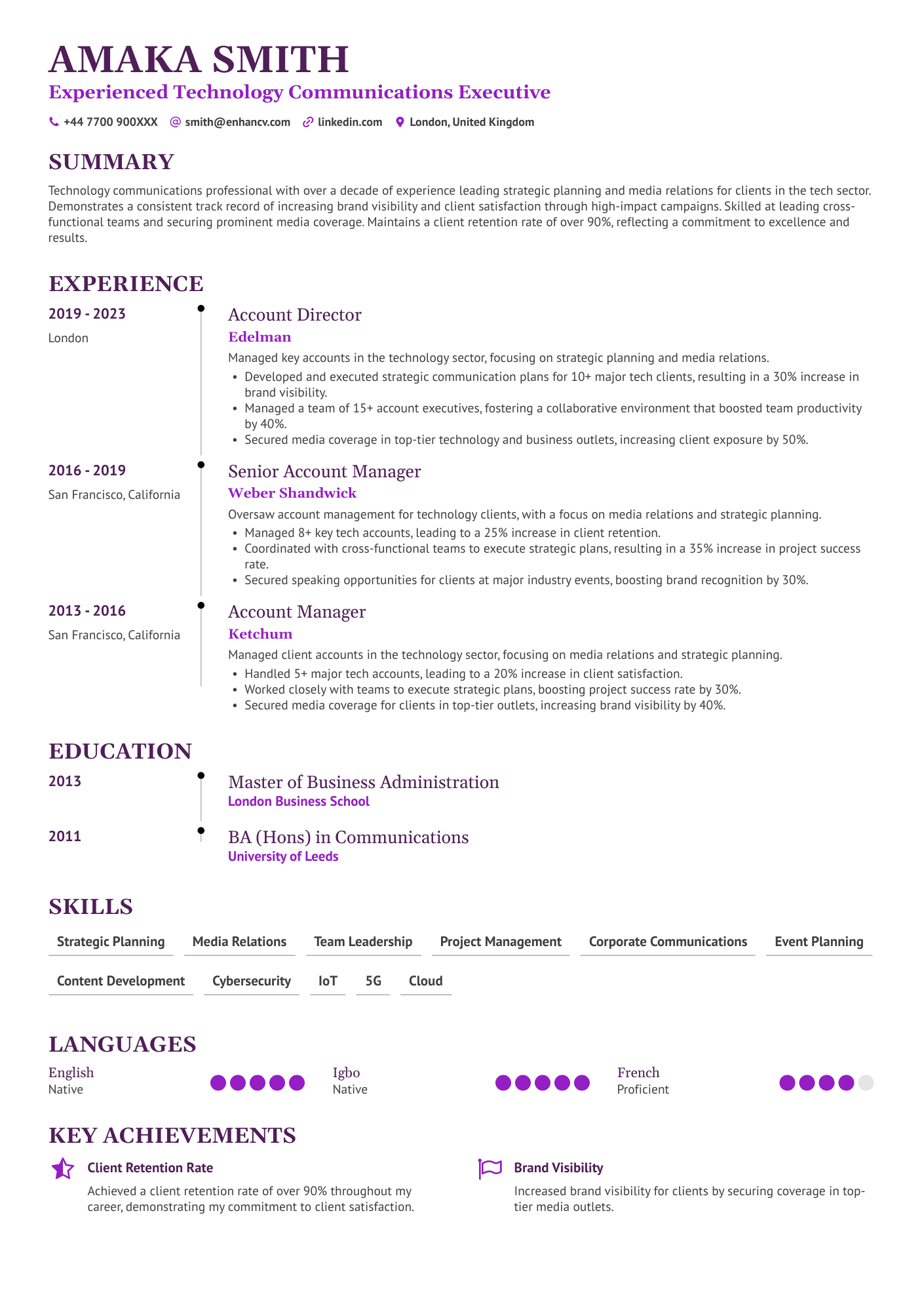You’re a great fit for the role—right experience, solid skills, the qualifications to match. But if your CV doesn’t show that clearly, you could miss out. So, which format should you choose?
Most hiring managers don’t have time to play detective. If they can’t spot your most recent role in seconds, they could end up moving on. That’s where the reverse chronological format comes into play.
There’s a reason most employers lean toward this CV format. It’s straightforward, familiar, and makes their job easier. When done well, it gives your strongest roles the spotlight and keeps the rest tidy and clear.
Think that this CV format will work for you? If you’ve steadily climbed the career ladder, you might just be right.
In this guide, we’ll walk you through exactly how to structure your CV in reverse chronological order, so the right details stand out for all of the right reasons.

Key takeaways
- Reverse chronological is the go-to format for most UK hiring managers, especially in traditional industries.
- It’s very ATS-friendly, meaning it can easily get past the scanners.
- To create a reverse chronological CV, start with your most recent experience and work backwards—keep the timeline tight and tidy.
- Use consistent date formatting (month and year only) to clearly present your latest work and educational experience first.
- Keep bullet points sharp, focused on results, and never longer than they need to be.
What is the reverse chronological format?
Reverse chronological format is exactly what it says on the tin. It means listing your experience from newest to oldest. You start with your most recent job and work backwards.
The same goes for the education section, training and courses, or anything else that’s date-based.
If your recent roles are the strongest and most relevant to your career, this layout gives them top billing. It also helps hiring managers track your career progression at a glance without having to dig for it.

Hiring managers prefer the reverse chronological
The numbers don’t lie. Three out of four hiring managers (75%) say they prefer CVs that list the most recent work experience first, rather than those organised by skills or job function.
Benefits of the reverse chronological format
Before you set your sights on this format, it’s smart to consider its benefits. Understanding what advantages the structure holds will help you make а decision.
It’s the classic format recruiters expect
You’re not looking to surprise anyone, least of all the hiring manager. The reverse chronological format is the standard layout for CVs in the UK. It’s what the reader expects to see.
Since it’s familiar—not to mention easy to follow—the hiring manager will have no problem reviewing your application. The easier you make it for them, the better your odds of success.
It works well with ATS systems
Applicant tracking systems (ATS) aren’t the be-all, end-all. However, you should factor them into the decision of which CV format to use.
The software may be built to read CVs in a certain way, and that is likely to be linear. The reverse chronological format makes it easy for them to scan and sort your info without any issues.
It highlights your career progression
Your CV has the potential to tell a powerful career story, but only if you do it right. Positioning your experience in a linear way means that you’re already ahead of the game.
If your recent roles show career growth, this format puts that front and centre. Employers can quickly see how you’ve moved up or taken on more responsibility over time.
Who is the reverse chronological CV for?
Not sure if the reverse chronological CV is the right fit? It’s a strong option if your work history is steady and your most recent roles are the ones you want to highlight.
This CV is effective for jobseekers looking to highlight career progression, skill-based or relevant work experience and a solid work history.
This format is widely accepted and is the best suited for traditional industries or applications where your experience is important.
This CV structure suits professionals with a consistent background, people moving up in their careers, and job seekers staying within the same industry. It’s also a safe bet in more traditional fields like law, finance, and academia. And it doesn’t end there.
Even students or recent grads can make it work, especially if they’ve picked up some relevant experience along the way.
Who should use a reverse chronological CV?
| Career type | Why reverse chronological order works |
|---|---|
| Consistent work history | This format shows a clear timeline and steady career path. It’s great for professionals with no major gaps. |
| Solid career progression | If you have a linear career history, this choice puts your most recent (and usually most senior) roles right at the top. |
| Traditional sectors | The reverse chronological format is preferred in fields like law, finance, and academia, where CV conventions matter. |
| Students or recent grads | This format can work for you when you have some relevant placements or internships. |
| Freelancers or gig workers | If you’ve worked on multiple short-term projects, this format can look quite jumpy. However, if you've had longer-term contracts or repeat clients, a reverse chronological CV can still work well. |
| Job seekers applying to large companies | Large companies are almost certain to use ATS software. For that reason, it’s smart to use the reverse-chronological format. |
How to write a reverse chronological CV, explained
Ready to get started? We’ll take you through how to build a clean, easy-to-follow reverse chronological CV.
Here are three things you should remember:
- Highlight what matters first: The reverse chronological format puts your most recent and relevant experience at the top, making it easy for employers to see your current strengths right away.
- Focus on clarity: The aim of the game is to make it simple for the reader. Make sure the content of your CV shines above everything else.
- Start with your most recent experience: To get started, you always need to lead with your most recent roles and training. That’s what matters here.
Since this is the most popular structure, chances are, you’re already familiar with it. However, it’s worth refreshing your memory, especially if it’s been a while since you last wrote a CV from scratch.
What I’m looking for is clear structure: strong headlines, reverse-chronological work history, quantifiable achievements, and no unnecessary fluff.
Here’s a rundown of each section in order, and how it might look:
CV header
Your CV header sits at the top of the document. It’s a small but mighty part of your application, featuring your basic contact details, as follows:
- Full name
- Professional title (if relevant)
- Location (city and county is enough)
- Email address
- Phone number
- LinkedIn or portfolio link (optional)
CV summary
Next up, you’ll want to tackle the CV summary. This is a short paragraph (around three to four lines max) that explains who you are and what you bring to the table. Don’t let it spook you, but lead with value.
- Mention your job title and level (e.g. mid-level marketing manager).
- Include your most relevant experience or achievement.
- Name-check your key skills or industry focus.

PRO TIP
Just starting out? Go with an objective instead.
CV summaries are great for drawing attention to career highlights. But if you’re fresh to the job market, there might not be much to summarise yet. An objective lets you focus on your goals and what you’re aiming to bring to the role.
Don’t make the mistake of using a one-size-fits-all approach. You should always tailor your summary to the job at hand. Research the company and ensure the statement aligns with its culture.
Experience
This is the star of the show. Or, at least, it should be. To craft this section, list your work experience from most recent to oldest. Each entry should include:
- Job title
- Company name
- Location
- Job description (optional)
- Dates of employment (month + year)
- Three to six bullet points of what you did and achieved
Start each of the bullet points with action verbs to make sure they have real impact. You should also include metrics such as numbers and statistics to back up your claims.
- •Planned and delivered over 140 lessons, helping 89% of students achieve grades 6–9 at GCSE level
- •Designed mock business scenarios to teach core topics such as marketing, finance, and operations, improving student engagement by 35% (based on student surveys)
- •Implemented targeted revision sessions using past data, raising average A-Level scores by 15%
- •Mentored five students for university applications in business-related fields, all of whom received offers
Education
Stick with the same format when writing your education section. List your most recent feats at the top of this section, and then work your way back in time.
Include the following:
- Degree or qualification
- School or university
- Year of graduation or expected graduation date
- Grade or classification (if strong or relevant)
Have you completed extra courses along the way? Don’t be afraid to shout about them. You can either include these in your education section or in a separate certificate section.
Skills
Next up, you can move onto the skills section.
There are two types of skills to include: hard skills—technical abilities gained through training or hands-on work—and soft skills, which come from real-life interactions and communication.
When working on your skills section, list six to ten hard or technical skills only. Soft skills tend to fall flat without any context, and so it’s better to focus on tangible talents.
Here’s how you can get that right:
- Select the right skills to put on your CV (by analysing the job advert first).
- Find keywords associated with the role and use them in this section.
- Include relevant, job-specific skills supported by measurable achievements.
- You may include some high-value soft skills as long as they’re relevant and illustrated through real-life examples.
- Finally, add a proficiency level to each talent.
Avoid vague terms like “good communicator” unless you plan to back this up elsewhere. These generic skills only waste space, and add very little to your application.
Let’s take a look at an example:
Optional extra sections
You should only include these if they add real value to your application and—this is crucial—if you have the space. Cramming them in for no reason is a mistake.
Consider what each one says about you as a candidate, and whether it’s worth the trouble.
Here are some extra CV sections that you can include:
- Certifications or training
- Volunteer work
- Language section
- Awards or publications
- Hobbies and interests
Here’s an example of a reverse chronological CV, created using Enhancv’s AI CV builder. Our Timeline template works perfectly for such CVs, thanks to its single-column layout and strong visual emphasis on chronology.
Now that you’re clear on which sections to include, let’s move on.
In this next part, we’ll take a quick look at a reverse chronological format template.
Reverse chronological CV template
Want a no-fuss CV that does exactly what it needs to? This one’s for you. By now, you know the reverse chronological format is the standard for a reason. It’s clear, familiar, and does a great job of showing off your most recent (and hopefully most relevant) experience.
The layout below puts all of that into practice. You can easily adapt it using the word-processing platform of your choice—whether that’s Word, Google Docs, or anything else you’re comfortable with.
Name Surname
Job Position
(000) 000-0XXX | Name.Of.Candidate@email.com | @LinkedIn | Location
Summary
Briefly summarise your key strengths, years of experience, industry expertise, and what sets you apart. Avoid personal pronouns and focus on your value to employers.
Experience
Job title
Company, Location
Month Year – Month Year
- Bullet point describing your main responsibility or achievement
- Bullet point with a measurable result or impact
- Bullet point focusing on leadership, collaboration, or innovation
Job title
Company, Location
Month Year – Month Year
- Bullet point describing your main responsibility or achievement
- Bullet point with a measurable result or impact
- Bullet point focusing on leadership, collaboration, or innovation
Education
Degree Title
University Name, City
Graduated: Year
- Relevant course/module or achievement
- Extracurricular involvement or academic award
Certifications
- List 2-3 certifications, including the year.
Skills
- Skill or tool name
- Programming language or platform
- Industry-specific tool or methodology
Languages
- Language (Fluent/Native/Professional Proficiency)
- Language (Conversational/Basic)
The template follows the structure we've covered, starting with your latest role and working backwards, keeping the layout clean and easy to scan. There’s space for everything that matters: a sharp summary, a strong work history section, education, skills, and any extras you want to include.
Or, if you’d rather start with a professionally designed template, our drag-and-drop CV builder makes it easy to create a standout CV in minutes.
How to format your reverse chronological CV
You’ve got the content down. Now, you need to make sure it’s easy to read. Formatting can make or break a CV, no matter how strong your experience is.
If you’ve decided to use the reverse chronological format, that’s a good start. But why stop there?
Here are some of the ways you can elevate the structure of your professional CV:
#1. Use consistent date formatting
First up, pick a style and stick to it. Including the month and year is the standard, but how you do it matters too. Don’t mix styles halfway through your CV, or that could be a red flag for the hiring manager.
Formatting your dates
Stick to a consistent format like MM/YYYY. Start with your most recent roles or education and work backwards. Keep the dates aligned—ideally to the right—so it’s easy for recruiters to scan. No need to include exact days.
Like so:
Office Manager
ClickUp, London
06/2023 – 05/2024
#2. Keep bullet points short and sharp
Bullet points make your CV more skimmable… but they only work if they’re short. Each point should be no longer than a single sentence. (Two at most—but use this rule sparingly!)
To get the most bang for your statement, start with a strong verb, skip the waffle, and focus on outcomes. You can take things to the next level by adding in some choice metrics, too.
Short and sharp points
- Boosted email open rates by 22% via A/B testing.
- Managed £100k+ budget paid social campaigns on Facebook and Instagram.
- Improved on-page content reducing bounce rate by 18%.
See how that’s easy to read and has real impact? That’s good stuff.
For context, here’s what not to do:
Long and convoluted points
- Helped the team improve traffic to the website through a range of SEO techniques, including keyword research and updating some content across various pages.
- Took part in managing the company’s social media campaigns on different platforms like Facebook and Instagram, and sometimes helped with the budgeting side of things when required
- Assisted in carrying out tasks related to email marketing campaigns, including writing emails, building mailing lists, and reviewing the results after the campaigns were finished
- Worked alongside the design and content teams to help make changes to the website that would hopefully lead to better user experience and engagement over time
#3. Stick to standard fonts
The fonts you use matter more than you might expect. Keep sizes consistent. Opt for 10 to 12pt for your body text, and then 14–16pt for section headings.
When it comes to typefaces, go for something simple and easy to read. We’re talking Arial, Calibri, Lato, Rubik, Times New Roman, and Helvetica.
#4. Use clear section headings
Your number one priority should always be readability. Make it easy for the hiring manager to jump from summary to experience to skills. You don’t need to get fancy. Simply call each section what it is. Creative headings like “My Journey” might look nice, but they can confuse ATS systems. Stick with standard titles like “Professional Summary.”
Once again, you’ll want to make sure the font size and type is consistent throughout your CV. Small changes are noticeable and will make it look like something is “off” with your document.
#5. Don’t overdo it with design
Unless you work in a creative field, avoid CV templates with wild colours, icons, or a tonne of columns. Go for a design that’s simple, clear, and easy to scan for both the eye and ATS systems.

PRO TIP
It's not just about making your CV look attractive. Design psychology says people read in patterns (like F-shapes or Z-shapes).
Put the most important stuff—job titles, companies, dates—at the top of the page. That way, they will see the information that matters first.
Make sure every part of your CV follows a logical pattern. A tidy layout makes you look organised before they’ve even read a word.
#6. Keep it to one or two pages
Want to know how long your CV should be? We recommend one to two pages. Two pages is totally fine, especially if you’ve got a few years under your belt.
However, don’t be tempted to pad it out. You only include what actually supports your application. Make sure your years of experience dictate how long your CV is.
Remember, formatting doesn’t have to be overly complicated. When you’re working on your CV, keep things clear, consistent, and professional. Using the advice we’ve shared above is a smart place to start.
When not to choose the reverse chronological format
There might be situations when the reverse chronological CV is not the right path.
Here are three times to avoid it:
You’ve got gaps in your work history
Whether it’s time off for travel, parenting, health, or anything else, it doesn’t matter. This format can make those career breaks feel more obvious than they need to be. A different layout, such as a skills-based format, might give you more control over the story you're telling.
You’re switching careers completely
Are you shaking things up? If your past job titles don’t line up with your goals, a skills-based or a hybrid CV is often a better bet. This choice puts the focus on what you can do, not your experience.
You’re looking for your first proper job
Welcome to the working world! If you don’t have much (or any) work experience yet, the standard format can look a bit bare. You may be better off leading with the skills you’ve learned during projects or your education. Try using a skills-based (functional) CV format to help you do just that.
Takeaway
The reverse chronological format is by far the most popular structure—with hiring managers and beyond. If you’ve had a somewhat traditional career, it’s certainly the way to go. However, it’s not the only option. Be sure to check out the other CV formats and weigh up their advantages before you make your decision. Above all else, make sure the most impressive content of your CV is front and centre.




